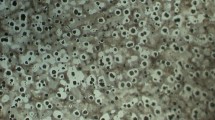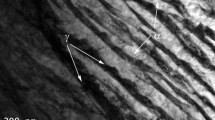Abstract
Surface modification of mild steel was undertaken using two covered electrodes and two tubular electrodes. The two covered electrodes are DIN 8555: E6-UM-60 and E10-UM-60GR; however, the two tubular electrodes are E10-GF-60GR1 and E10-GF-60GR2. Chemical analysis for the weld metal and XRD of the flux covering for covered electrodes and flux core for tubular electrodes were conducted. The most important factor in determining the wear resistance is the microstructure of the deposit layers. In similar carbon equivalent electrodes E10-UM-60GR and E10-GF-60GR1, electrode E10-GF-60GR1 (tubular) shows larger carbides area fraction and better wear resistance than electrode E10-UM-60GR (covered). This could be attributed to a lower dilution associated with tubular electrode compared with covered electrode. The two tubular electrodes showed higher wear resistance than the covered electrodes which is mainly due to the larger Fe-Cr carbide precipitation area fraction.












Similar content being viewed by others
References
Welding handbook: Materials and applications, Pt.1, Vol. 3 (1996) , 8th ed., AWS, Miami, Florida, pp. 252–254.
Welding handbook, materials and applications, Pt.2, Vol. 4 (1998), 8th ed., AWS, Miami, Florida, pp. 409–412
Bundinski K.G (2004) Surface coating technology, pp. 188–189.
Wu JBC, Redman JE (1990) Welding Journal 73(9):63–68
Kotecki DJ, Ogborn JS (1995) Welding Journal 74(8):269–288
Gregory E.N (1975) Welding research bulletin pp. 69–71.
Berns H, Fischer A (1985) Proceedings of the fifth International Conference on Wear of Materials, Vancouver, Canada, Vol. 5 , pp. 625–633
Murugan N and . Parmar R.S (1997) Welding Journal, Vol. 76, No. 10, pp. s.391–s.403.
Mitchell K (1998) Weld. Metal fabrication, Vol. 66 , No. 7, pp. s.16–s.20.
Klimpel A, Dobrzanski LA, Janicki D, Lisiecki A (2005) J Mater Process Technol 164–165:1056–1061
Bazhenov V, Pikunov M (2011) Steel in Translation 41(11):896–899
Sil’man G (2002) Metallov. Term. Obrab. Met., , no. 1, pp. 26–29.
Buchanan VE, Shipway PH, McCartney DG (2007) Wear 263:99–110
Dwivedi DK (2004) Mater Sci Technol 10:1326–1330
Dogan ON, Hawk JA, Laird G II (1997) MetallMater Trans A 28A:1315–1328
Author information
Authors and Affiliations
Corresponding author
Additional information
Doc. IIW-2447, recommended for publication by Commission I "Thermal Cutting and Surfacing.
Rights and permissions
About this article
Cite this article
Morsy, M., El-Kashif, E. The effect of microstructure on high-stress abrasion resistance of Fe-Cr-C hardfacing deposits. Weld World 58, 491–497 (2014). https://doi.org/10.1007/s40194-014-0132-0
Received:
Accepted:
Published:
Issue Date:
DOI: https://doi.org/10.1007/s40194-014-0132-0




